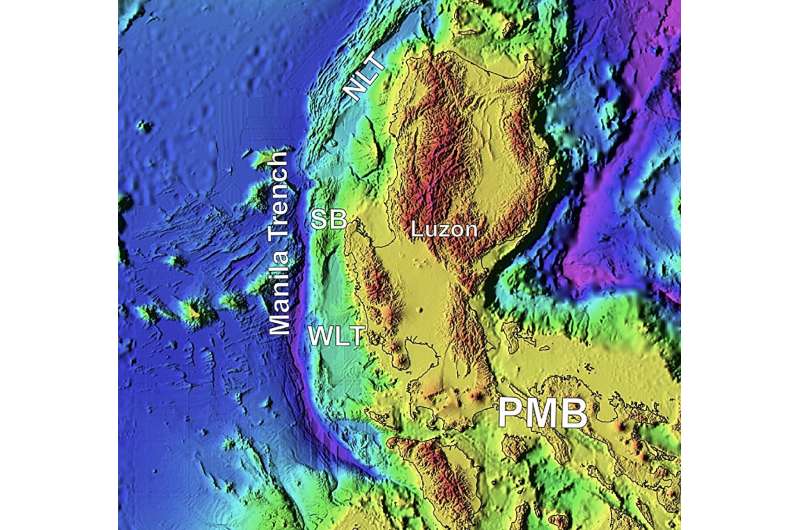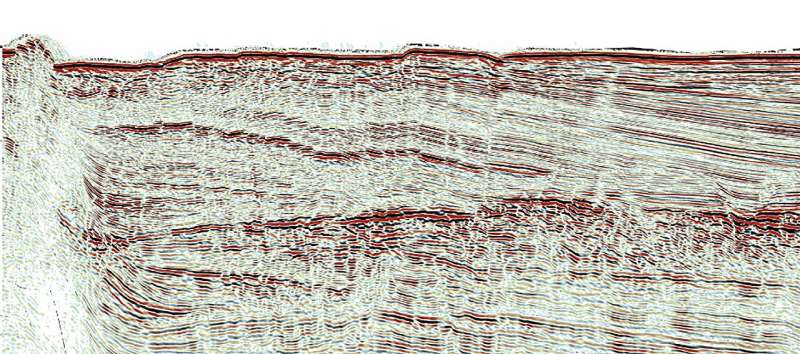This article has been reviewed according to Science X's editorial process and policies. Editors have highlighted the following attributes while ensuring the content's credibility:
fact-checked
proofread
Geologists discover evidence of gas hydrates in the Manila Trench

Gas hydrates are great alternative energy sources but they could also harm us and the environment, note geologists from the University of the Philippines.
Much like carbonated drinks are water infused with carbon dioxide, gas hydrates are ice mostly infused with methane, a natural gas used as fuel. Gas hydrates are ice-like substances that usually only form beneath the seafloor, where the pressure is high and the temperature is just below the water's freezing point of 0°C.
Elisha Jane Maglalang, Dr. Leo Armada, Madeleine Santos, Karla May Sayen, and Dr. Carla Dimalanta of the UP Diliman College of Science National Institute of Geological Sciences (UPD-CS NIGS) discovered that gas hydrates may be abundant in the Manila Trench, west of Luzon. Their study, published in Marine and Petroleum Geology is the first to investigate these substances in Philippine trenches, pioneering gas hydrate research in the country.
Because gas hydrates contain huge amounts of carbon and methane, they can be a great alternative energy source. "The western Philippines has vast potential for this unconventional energy resource," the researchers said. They discovered that a total area of about 15,400 square kilometers in the Manila Trench, or about the size of Palawan, could contain gas hydrates. They estimate these substances might be around 200 to 500 meters below the seafloor.
However, gas hydrates can be a geologic and environmental threat. Because gas hydrates are unstable solids, they will dissociate and melt when the conditions in which they form change, usually during earthquakes. Worryingly, the Manila Trench is an active margin, responsible for numerous earthquakes in Western Luzon. When gas hydrates melt, it will agitate the seafloor, possibly triggering submarine landslides and tsunamis.

Moreover, methane can harm the environment when released into the atmosphere. Methane is a potent greenhouse gas that contributes to global warming, and just one cubic-meter block of gas hydrate contains as many as 160 cubic-meter blocks of methane in its gas form. This is equivalent to 14% of an average Filipino's methane emission in 2021.
"Therefore, it is essential to determine the distribution and stability conditions of gas hydrates offshore of the Philippines," the researchers emphasized.
To determine their location without drilling through the seafloor, scientists rely on sound waves. Similar to how a pond reflects sunlight, gas-bearing substances like gas hydrates reflect sound waves. These seismic reflections, called bottom-simulating reflectors (BSRs), indicate where gas hydrates might be present. By analyzing existing seismic data in the Manila Trench, the UP geologists were able to map out BSRs and, consequently, deduce possible locations of gas hydrates in the region.
The researchers note, however, that while BSRs are tell-tale signs of gas hydrates, they are not definitive. "Future drilling of offshore targets will be instrumental in confirming methane hydrate occurrence," the researchers said. "These investigations offer a vital opportunity to develop our indigenous energy wealth."
To move forward, the researchers are conducting additional investigations in other offshore places in the Philippines to expand our geophysical dataset. Moreover, the team is spearheading efforts to foster marine geophysics in the country. "These efforts will contribute not only to the advancement of scientific knowledge but also to the development of the expertise of Filipino geoscientists in marine geophysics," they concluded.
More information: E.J.M. Maglalang et al, Bottom simulating reflectors in the Manila Trench forearc and its implications on the occurrence of gas hydrates in the region, Marine and Petroleum Geology (2023). DOI: 10.1016/j.marpetgeo.2023.106538
Provided by University of the Philippines





















